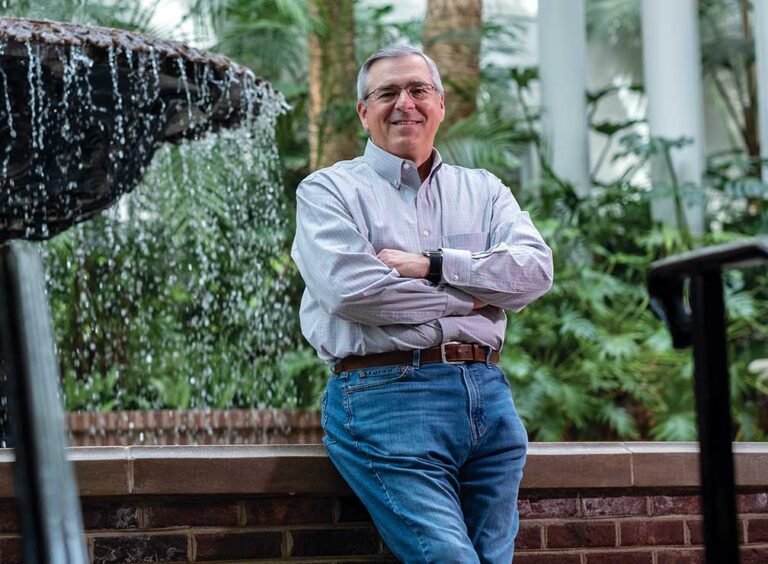As Truckload Carriers Association (TCA) Chairman John Culp enters the second quarter of his term, motor carriers continue to face challenges posed by rising costs in and an economy that might best be described as “stagnant.” Recently we had a chance to sit down and visit with Culp about a few of the issues driving the overall cost of trucking upward, from zero-emissions regulations and alternate fuel sources to the prevalence of high-dollar awards to plaintiffs against motor carriers and truck drivers, the continuing debate about classifying works as independent contractors or company employees, and more. Settle in for an in-depth discussion!
Linda: Good morning, Mr. Chairman. As you begin the second quarter of your tenure as TCA chairman, what issues stand out in your mind as the highest priority for the truckload segment of the freight industry?
John: I would say the biggest issue for the industry is dealing with increasing costs in a very challenging rate environment. Contract rates are hurting, and spot rates are unsustainable. The market will shift, but it will be a battle until it does. The rising cost of liability insurance is one cost that is particularly bad. Unfortunately, it is going to take litigation reform to reign it in — and that is not something that will happen quickly. It will take a concerted effort at both the national and state levels. TCA is working to help keep this issue at the forefront of stakeholders’ attention at both levels.
Linda: The push for zero-emission commercial vehicles continues, and it seems many groups are focusing on battery electric trucks as an “immediate” solution. What other options should the industry consider?
John: Another big issue we are working on is educating the public on the cost of both battery electric vehicles (BEVs) and the electric infrastructure needed to power them. Our country is enamored with battery electric vehicles as THE solution to protecting the environment, and while it will be part of the solution, the cost and targeted time frame for our industry to implement is simply unrealistic. BEVs can be part of a long-term comprehensive solution, but it is imperative that we also utilize other options available that have more immediate impact, especially for the trucking industry.
The focus on “zero tailpipe emissions” ignores the massive carbon generation that occurs on the BEV mining and production side. These issues are clearly articulated in new research from the American Transportation Research Institute (ATRI), which released a report just this spring on Renewable Diesel. The report identifies and highlights substantial environmental and cost benefits that internal combustion renewable diesel (ICE RD) engines have in truck life-cycle CO2 over the truck life-cycle CO2 of BEVs.
According to the report, an ICE RD provides a 67.3% decrease in per truck life-cycle CO2 compared to an ICE diesel, with no operational changes. A BEV using today’s technology, on the other hand, offers only a 30%-39.5% decrease in per truck life-cycle CO2 — with a limited range and cargo capacity on top of substantial operational challenges.
The projected cost to reach a 22.6% CO2 decrease over a 15-year period is $203 billion for ICE RD, as opposed to $1,190 billion for BEV. That’s a cost of $8.982 billion per percentage point for ICE RDs compared to $52.654 billion for BEVs.
Linda: That’s a pretty significant cost difference. Why isn’t the entire nation jumping on the idea of converting to ICEs fueled by RD?
John: While these numbers might look like a no-brainer, the adoption of RD does face political headwinds, particularly because of the zero-tailpipe emissions aspect. That will take time to resolve because of a few factors.
- Feedstocks are needed to produce RD. While current production has kept up with growing demand, second- and third-generation feedstocks will have to be developed to meet the demand of the future.
- While the full impact of subsidies on the RD market is not known, they are clearly encouraging production. Should subsidies be removed from the market too early, supply may decrease.
- Sustainable Aviation Fuel (SAF). Interest is growing in SAF, which uses similar feedstocks and processes for production. It is possible that public policy could shape the SAF market and divert RD from the trucking industry, thus working against industry efforts to decarbonize.
Linda: What other possible solutions can be explored?
John: Converting to RD is not the only other option for consideration in our comprehensive long-term solution for environmental sustainability. Hydrogen fuel cells or other alternative fuels can play a role — but one thing we can do in the immediate/short-term horizon is to promote and incentivize replacement of pre-2010 engines, which represent approximately 45% of the nation’s heavy-duty trucks with modern engines. Replacing those trucks with modern engines would reduce truck emissions by over 80%. That would be a massive reduction!
Another idea is to incentivize truckers to upgrade their older vehicles. Both TCA and the American Trucking Associations (ATA) are advocating the repeal of the Federal Excise Tax (FET) of 12% that is charged on the purchase of new tractors. The 12% equates to almost $17,000 on a truck that costs $140,000. The FET is an outdated, regressive tax that increases every year with inflation and needs to be repealed. It would be good for both our industry and the environment.
Linda: Lawsuits resulting in exorbitant penalties against trucking companies continue to plague the industry. In fact, numerous states have considered bills to address the problem, with varying degrees of success. In your opinion, what is the biggest hurdle that is preventing the passage of such legislation?
John: Exorbitant jury awards and settlements, aka “nuclear verdicts,” are a tremendous problem for the entire trucking industry. Unfortunately, accidents happen, and sometimes people are seriously or fatally injured. When this happens, our legal system allows the injured party to seek recovery and/or damages from the party that was responsible for the accident. This is a good thing, and that is what insurance is for.
Trucking companies are required to carry a minimum of $750,000 of insurance coverage. That figure was set in 1980 and has not been updated since. It is well below what is needed to cover the cost of serious accidents today. If adjusted for inflation using CPI and medical cost inflation numbers, it is fair to say that today’s minimum liability limits would reasonably fall within the range of $3-$5 million. But that’s an issue for discussion at another time.
To answer your question about the biggest hurdle preventing passage of legislation: It’s opposition from plaintiff attorneys and their massive lobbying dollars.
Have you noticed the TV commercials and billboard advertisements from personal injury attorneys targeting “big truck accidents”? You can’t miss them; they’re everywhere! It’s big business and has become a specialty industry. The plaintiffs’ bar is highly organized and very good at what they do.
I’m not saying personal injury attorneys are bad people, but the big boys who are driving the problem are specialists who focus on big cases involving trucking companies who have lots of insurance and/or assets. They game the legal system, disparaging our industry and convincing juries that truckers are bad actors that need to be punished. Some might be, but not even that justifies the lottery jackpot verdicts and settlements that have gone ballistic over the last 10 years or so.
The awards are so big that they have investors who will finance the cost of multi-year litigation for big returns on their investment. They venue-shop for states that have favorable judicial procedures, precedents and big-verdict judgements and that do not have noneconomic damage limits.
Educational opportunities promote litigation.
These parties also provide educational opportunities to teach other attorneys how to maximize their jury awards and settlements in big truck accidents. I recently saw an advertisement for an upcoming seminar, the “2024 Big Truck and Auto Summit,” for plaintiffs’ attorneys. The event has 24 expert speakers, three of which boast a combined total of $2.1 billion in awards and settlements. I would agree that they are experts indeed. I don’t know what they will be teaching, but a common method used for obtaining big verdicts and judgements since 2009 has been known as the Reptile Theory.
An article from Courtroom Sciences, Inc., titled “Reptile Theory at Deposition: Extinct or Evolved?” examines the misunderstanding of Reptile Theory and exposes the psychological principles plaintiff attorneys use to achieve disproportionately high dollar settlement and trial verdicts. Reptile Theory has been around a long time and has now been rebranded as the “Edge,” brought to you by the Keenan Trial Institute (KTI) and directed by original Reptile co-founder Don Keenan.
Litigation reform is desperately needed.
We need litigation reform in the worst way. Runaway “jackpot justice” has to be throttled back. It is unfair to the hundreds of thousands of trucking companies that move America’s freight and have to pay higher insurance premiums because of it. Airlines and railroads have protections that limit awards, but transportation litigation is like the Wild West.
Progress is being made in several states, but we have a long way to go. If we are going to be able to overcome the plaintiffs’ bar and their war chest of money, we need the public to support our efforts by talking to legislators and voting on litigation reform initiatives. We need to educate them on what is happening and how they are impacted. The truckload industry moves 73% of freight in the U.S., and these lottery award verdicts and settlements have and will continue to raise the cost of transportation that ultimately is passed on to consumers.
Linda: Is there hope for a solution at the federal level for the issue of nuclear verdicts?
John: I think there is some hope. It may be a pipe dream, but the trucking industry is critical to our nation’s supply chain. It is regulated by the federal government and should be adjudicated in the federal court system. In my opinion, this would be a huge step in the addressing litigation abuse. The federal government could also apply some type of noneconomic damage protection as it has done for airlines and railroads.
Linda: It’s no secret that times are tough in trucking, and most analysts predict that recovery will be excruciatingly slow. In your opinion, what are the key factors slowing this recovery?
John: Inflation and interest rates. Our economy is consumer-driven and continued inflation, especially for groceries, is hurting families. While the high interest rates impact businesses also, it has a much harder impact on consumers with credit card debt. Home sales for new and existing homes are at the lowest levels we have seen since prior to COVID. In my opinion, higher mortgage rates are the biggest reason.
Linda: On another topic, the independent contractor vs. employee classification debate continues across the country and impacts numerous industries. From a business perspective, how would reclassifying current independent contractors as an employee impact a company’s bottom line?
John: I’m not sure how to answer that because I think it would depend somewhat on the mix of independent contractors vs. company drivers for individual companies. The big issue is that independent contractors and employment do not fit together. The independent contractor model is a very important part of our industry, and it will go away if this happens. Nobody wins.
Linda: Looking forward to association events, TCA is holding the annual Refrigerated Meeting in Stowe, Vermont, in July. What topics will be addressed, and what benefits can carriers gain from this event?
John: At the TCA Refrigerated Meeting we’ll tackle key industry issues affecting those hauling temperature-controlled freight.
Educational sessions range from panels focusing on current and future supply chain challenges and opportunities to perspectives on the economic outlook of the segment, several interactive discussions on innovative technology with real-world carrier case studies, building successful customer-carrier relationships, and driver retention. Many of the sessions will encourage audience interaction and discussion so it’s a great way to learn from the experts as well as connect with peers.
There is also a golf tournament in the beautiful Green Mountains of Stowe, Vermont, and unique networking receptions and dinners. It’s a great chance to learn, connect, and stay ahead in the industry.
Linda: Thank you, Mr. Chairman, for your time and your insights. I look forward to our next visit.
Linda Garner-Bunch has been in publishing for more than 30 years. You name it, Linda has written about it. She has served as an editor for a group of national do-it-yourself publications and has coordinated the real estate section of Arkansas’ only statewide newspaper, in addition to working on a variety of niche publications ranging from bridal magazines to high-school sports previews and everything in between. She is also an experienced photographer and copy editor who enjoys telling the stories of the “Knights of the Highway,” as she calls our nation’s truck drivers.








